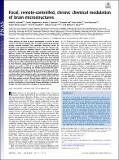| dc.contributor.author | Ramadi, Khalil | |
| dc.contributor.author | Dagdeviren, Canan | |
| dc.contributor.author | Spencer, Kevin C | |
| dc.contributor.author | Joe, Pauline | |
| dc.contributor.author | Cotler, Max Joseph | |
| dc.contributor.author | Rousseau, Erin Byrne | |
| dc.contributor.author | Nunez Lopez, Carlos | |
| dc.contributor.author | Graybiel, Ann M | |
| dc.contributor.author | Langer, Robert S | |
| dc.contributor.author | Cima, Michael J. | |
| dc.date.accessioned | 2019-03-01T18:55:24Z | |
| dc.date.available | 2019-03-01T18:55:24Z | |
| dc.date.issued | 2018-07 | |
| dc.date.submitted | 2018-03 | |
| dc.identifier.issn | 0027-8424 | |
| dc.identifier.issn | 1091-6490 | |
| dc.identifier.uri | http://hdl.handle.net/1721.1/120597 | |
| dc.description.abstract | Direct delivery of fluid to brain parenchyma is critical in both research and clinical settings. This is usually accomplished through acutely inserted cannulas. This technique, however, results in backflow and significant dispersion away from the infusion site, offering little spatial or temporal control in delivering fluid. We present an implantable, MRI-compatible, remotely controlled drug delivery system for minimally invasive interfacing with brain microstructures in freely moving animals. We show that infusions through acutely inserted needles target a region more than twofold larger than that of identical infusions through chronically implanted probes due to reflux and backflow. We characterize the dynamics of in vivo infusions using positron emission tomography techniques. Volumes as small as 167 nL of copper-64 and fludeoxyglucose labeled agents are quantified. We further demonstrate the importance of precise drug volume dosing to neural structures to elicit behavioral effects reliably. Selective modulation of the substantia nigra, a critical node in basal ganglia circuitry, via muscimol infusion induces behavioral changes in a volume-dependent manner, even when the total dose remains constant. Chronic device viability is confirmed up to 1-y implantation in rats. This technology could potentially enable precise investigation of neurological disease pathology in preclinical models, and more efficacious treatment in human patients. Keywords: brain; drug delivery; substantia nigra; neural implant; PET | en_US |
| dc.description.sponsorship | National Institutes of Health (U.S.) (Grant R01 EB016101) | en_US |
| dc.description.sponsorship | National Institute of Biomedical Imaging and Bioengineering (U.S.) (Grant R01 EB016101) | en_US |
| dc.description.sponsorship | National Cancer Institute (U.S.) (Grant P30-CA14051) | en_US |
| dc.publisher | National Academy of Sciences (U.S.) | en_US |
| dc.relation.isversionof | http://dx.doi.org/10.1073/PNAS.1804372115 | en_US |
| dc.rights | Article is made available in accordance with the publisher's policy and may be subject to US copyright law. Please refer to the publisher's site for terms of use. | en_US |
| dc.source | PNAS | en_US |
| dc.title | Focal, remote-controlled, chronic chemical modulation of brain microstructures | en_US |
| dc.type | Article | en_US |
| dc.identifier.citation | Ramadi, Khalil B. et al. “Focal, Remote-Controlled, Chronic Chemical Modulation of Brain Microstructures.” Proceedings of the National Academy of Sciences 115, 28 (June 2018): 7254–7259 © 2018 National Academy of Sciences | en_US |
| dc.contributor.department | Harvard University--MIT Division of Health Sciences and Technology | en_US |
| dc.contributor.department | Massachusetts Institute of Technology. Department of Brain and Cognitive Sciences | en_US |
| dc.contributor.department | Massachusetts Institute of Technology. Department of Chemical Engineering | en_US |
| dc.contributor.department | Massachusetts Institute of Technology. Department of Materials Science and Engineering | en_US |
| dc.contributor.department | Massachusetts Institute of Technology. Media Laboratory | en_US |
| dc.contributor.department | McGovern Institute for Brain Research at MIT | en_US |
| dc.contributor.department | Koch Institute for Integrative Cancer Research at MIT | en_US |
| dc.contributor.mitauthor | Ramadi, Khalil | |
| dc.contributor.mitauthor | Dagdeviren, Canan | |
| dc.contributor.mitauthor | Spencer, Kevin C | |
| dc.contributor.mitauthor | Joe, Pauline | |
| dc.contributor.mitauthor | Cotler, Max Joseph | |
| dc.contributor.mitauthor | Rousseau, Erin Byrne | |
| dc.contributor.mitauthor | Nunez Lopez, Carlos | |
| dc.contributor.mitauthor | Graybiel, Ann M | |
| dc.contributor.mitauthor | Langer, Robert S | |
| dc.contributor.mitauthor | Cima, Michael J | |
| dc.relation.journal | Proceedings of the National Academy of Sciences | en_US |
| dc.eprint.version | Final published version | en_US |
| dc.type.uri | http://purl.org/eprint/type/JournalArticle | en_US |
| eprint.status | http://purl.org/eprint/status/PeerReviewed | en_US |
| dc.date.updated | 2019-02-08T18:06:00Z | |
| dspace.orderedauthors | Ramadi, Khalil B.; Dagdeviren, Canan; Spencer, Kevin C.; Joe, Pauline; Cotler, Max; Rousseau, Erin; Nunez-Lopez, Carlos; Graybiel, Ann M.; Langer, Robert; Cima, Michael J. | en_US |
| dspace.embargo.terms | N | en_US |
| dc.identifier.orcid | https://orcid.org/0000-0002-5864-2386 | |
| dc.identifier.orcid | https://orcid.org/0000-0002-2032-792X | |
| dc.identifier.orcid | https://orcid.org/0000-0002-7963-8706 | |
| dc.identifier.orcid | https://orcid.org/0000-0002-2306-7537 | |
| dc.identifier.orcid | https://orcid.org/0000-0002-4326-7720 | |
| dc.identifier.orcid | https://orcid.org/0000-0003-4255-0492 | |
| dc.identifier.orcid | https://orcid.org/0000-0003-2379-6139 | |
| mit.license | PUBLISHER_POLICY | en_US |
